Spanning 268,596 square miles, Texas is the second-largest state in the US after Alaska. Therefore, it’s not surprising that it has rich and diverse ecosystems. Three of its borders are formed by rivers. The vast network of rivers helps to create many regions of swamps and wetlands.
These freshwater habitats are prime areas for alligators and there are between 400,000 and 500,000 of the powerful reptiles in the state. Alligators thrive in these areas and some can reach incredible lengths. But just how big can they get? Join us as we discover the biggest alligator ever found in Texas!
About Alligators
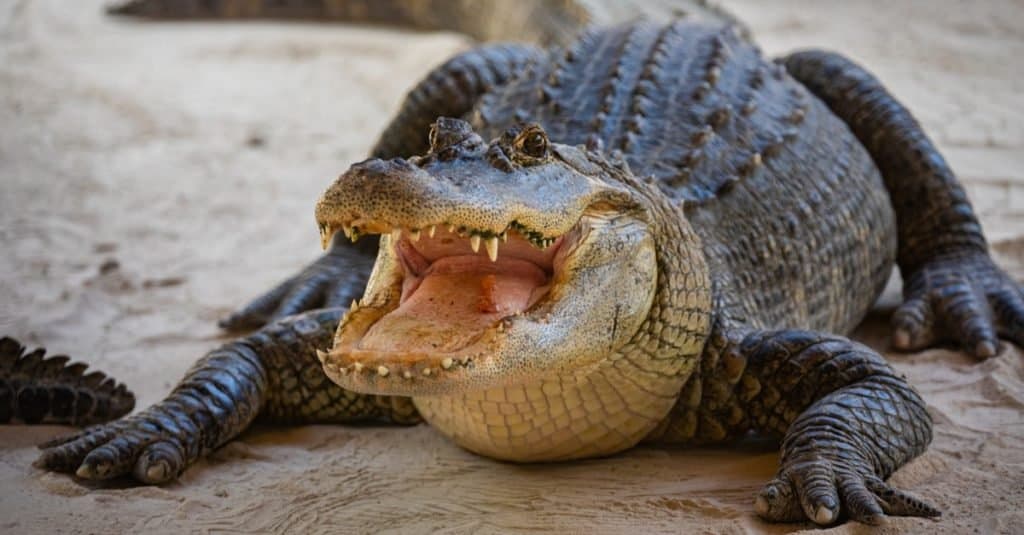
Alligators are powerful reptiles with incredible bite force.
©Mia2you/Shutterstock.com
Alligators are large, powerful reptiles from the family group Aligatoroidae which also includes caimans. They are native to only China, Mexico, and the United States. Alligators are distinguished by their dark olive or black bodies and white bellies along with their broad snout. There are currently two living species – the American alligator and the Chinese alligator.
The Chinese alligator is the smaller of the two species – reaching only between 5 and 7 feet long – and is critically endangered. American alligators are not endangered and are much larger, typically ranging between 11 and 16 feet long. Males are larger than females and size is generally related to age, with the oldest males being the largest.
The American alligator, in the wild, can live 35 to 50 years but in captivity, can live up to 80 years. The Chinese alligator has an average lifespan of 50 in the wild and up to 70 years in captivity.
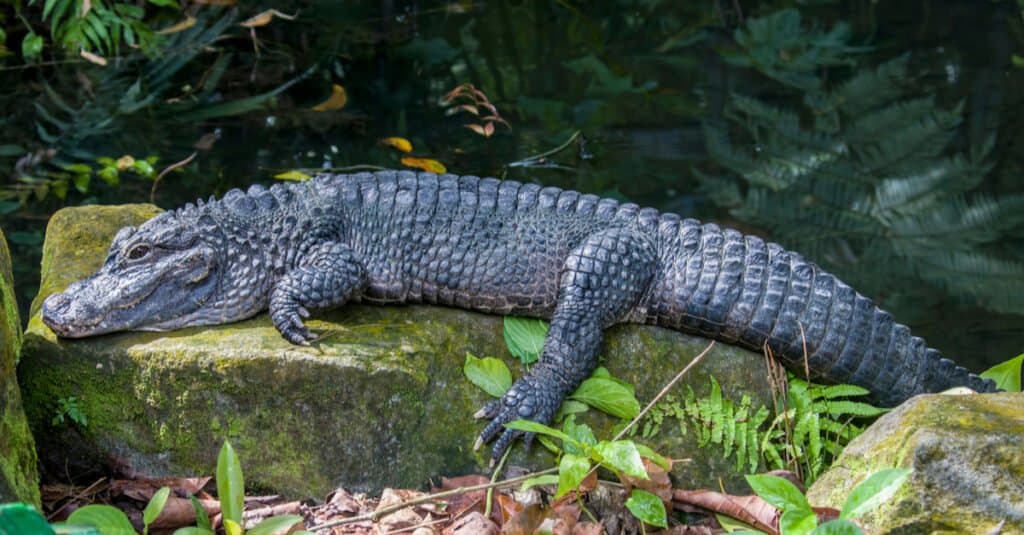
The Chinese alligator can reach a length of up to seven feet and weigh up to 100 pounds.
©Danny Ye/Shutterstock.com
Alligators typically live in freshwater environments such as swamps, marshes, ponds, lakes, and rivers. They have between 74 and 80 teeth which change as they get older. Young alligators have needle-like teeth which they use to prey on small animals such as insects, crustaceans, and fish. As alligators age, their teeth become stronger and more robust. This allows them to prey on much bigger animals – such as turtles, birds, and large animals up to deer. They are ambush predators and move quickly in short bursts in order to seize their prey. Smaller animals are grabbed and swallowed immediately while larger prey is usually dragged into the water and drowned.
As alligators are cold-blooded, their body temperature is dependent on their environment. Therefore, they spend much of their time basking in the sun near the shore. However, they quickly return to the water as soon as they are disturbed. Despite this, they can tolerate the cold quite well, and go into a shutdown state (known as brumation) for several days until the weather warms up again.
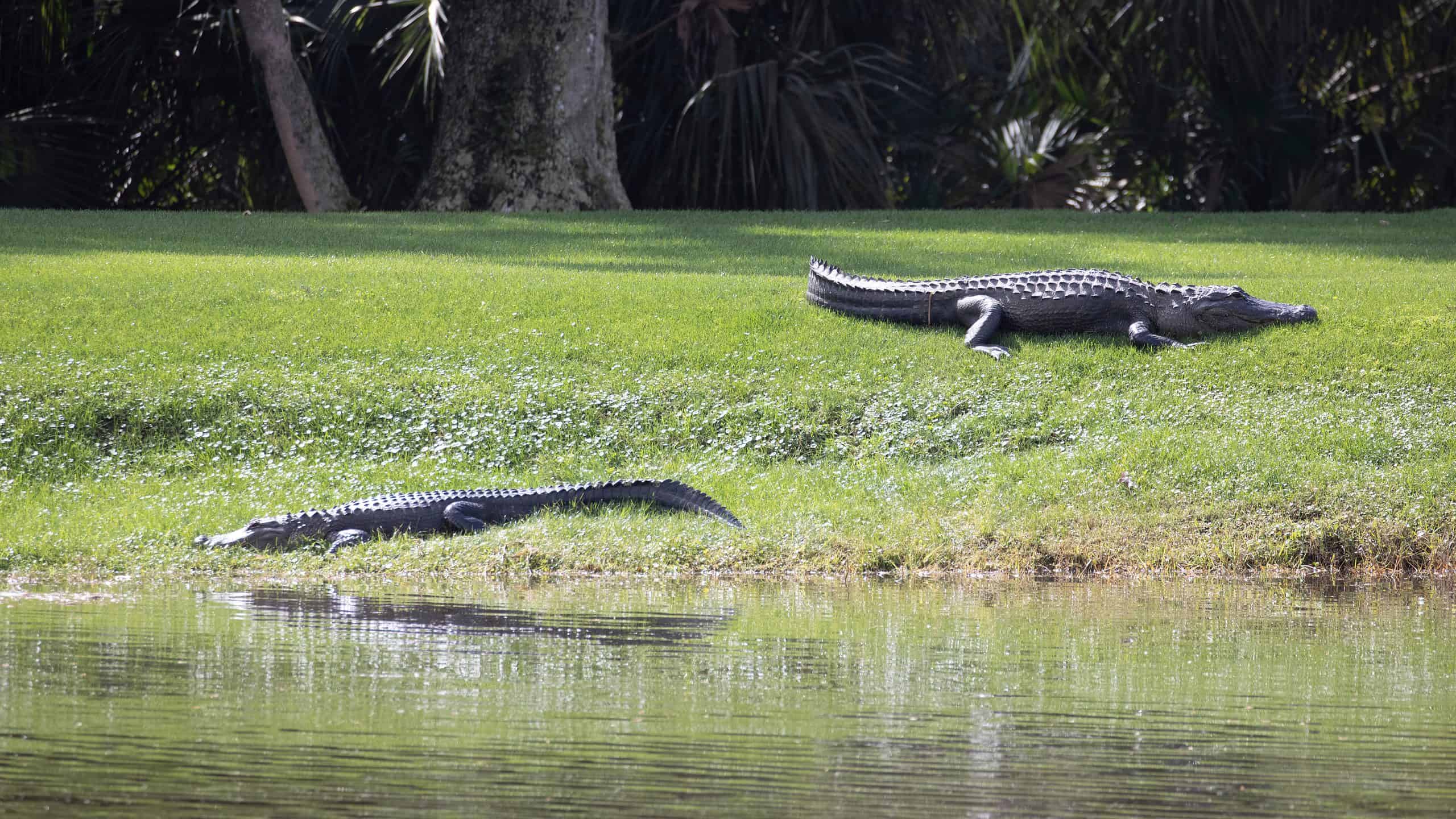
Alligators are frequently found basking in the sun.
©Danita Delimont/Shutterstock.com
Alligators “Water Dance”
Incredibly, a little-known behavior that alligators perform is a courtship ritual known as a “water dance”. While this involves the male letting out incredibly loud bellows above the water, the most important part is what he does under the water. The male first of all arches his tail and lowers his head just under the water. Underneath the water, the male now lets out deep, throaty sounds which are not audible to the human ear. However, they are at such a low frequency that the infrasonic waves produced cause the water over his back to ripple and jump, often making the water look as though it is boiling. This is known as the water dance and attracts the female.
After the courtship and mating, female alligators build a nest near the water in which she lays up to 50 eggs before covering them with vegetation. After around 65 days the baby alligators are born and the female carries them to the water in her mouth. Despite the size that they become, alligators begin life as tiny hatchlings which are no more than 8 inches long. Incredibly, it only takes them one year to reach 6 feet long which is classed as adulthood.
The Biggest Alligator Ever Found In Texas
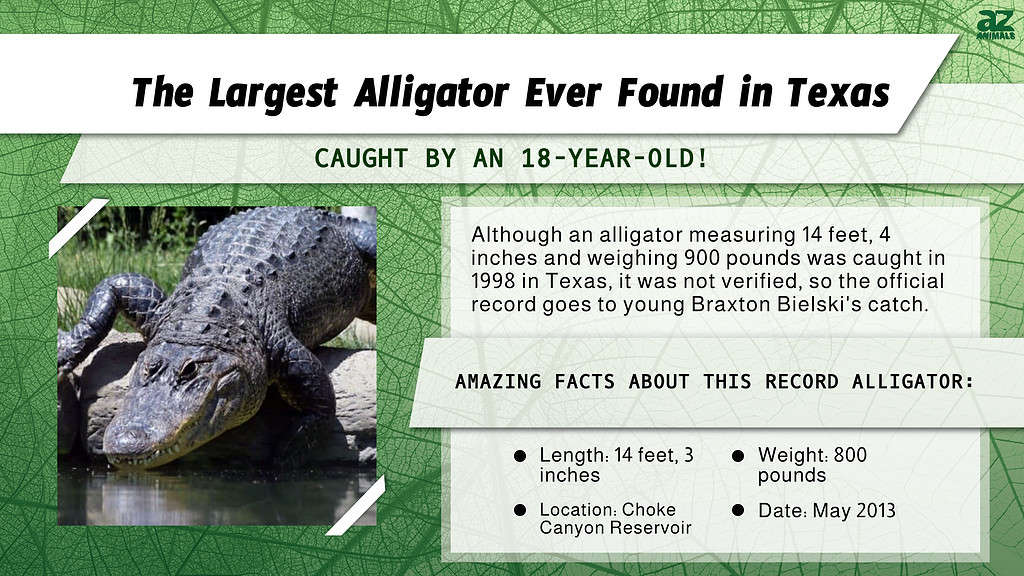
The biggest alligator ever found in Texas was an incredible 14ft 4 inches in length and weighed around 900 pounds. Although the massive beast was caught in 1998 it was not officially verified.
However, the official record isn’t much smaller and goes to a huge 14ft 3in long male alligator which was caught in May 2013. Weighing 800 pounds, the incredible animal was caught in Choke Canyon Reservoir by 18-year-old Braxton Bielski. Braxton and his father were some of a select few who were allowed to hunt there. Every year only a few permits are issued so that alligator numbers in the lake can be managed. The massive catch was even more remarkable as it was his first attempt at alligator hunting and no one expected him to catch anything – let alone anything that could be a record breaker.
Meet “Big Tex”
Although not the largest alligator ever found in Texas, Big Tex holds the record as being the biggest ever captured alive in the state. At 13ft 8in and weighing more than 900 pounds, capturing – and rehoming – Big Tex was no easy task. Originally living in Lake Champion at Trinity River National Wildlife Refuge, Big Tex was beginning to venture too close to the shore where people were fishing and taking photos. Although he didn’t attack anyone, his lack of fear towards humans was becoming too much of a risk and it was decided to catch and rehome him.
Gator Country – an alligator rescue facility in Beaumont – was chosen as his new home. However, first, they had to catch him. It took a lesson in patience to achieve it as Big Tex was lured in with pieces of chicken. Once close enough, the staff managed to get a rope around him, but Big Tex had other ideas about being caught. Quick as a flash, he headed back towards the water with staff trying their best to hold onto him. After a brief struggle they regained control of him and he was safely maneuvered onto a truck. He was then transported to the safety of Gator Country where another massive alligator also resides – “Big Al” who weighs more than 1,000 pounds.
How Do Alligators Compare?

As members of Alligatoroidae, alligators are also members of the order Crocodilia which includes all alligators, true crocodiles, caimans, gharials, and false gharials, along with many extinct members. The largest alligator ever found was 19ft 2in and was caught in Louisiana in 1890. This makes them significantly larger than caimans which reach a maximum of 13 feet long, and gharials which reach around 14 feet.
Alligators also compare well against crocodiles, not being much smaller than them. Although the size of crocodiles varies depending on species, the largest among them can reach more than 20 feet long, with the largest species being the saltwater crocodile.
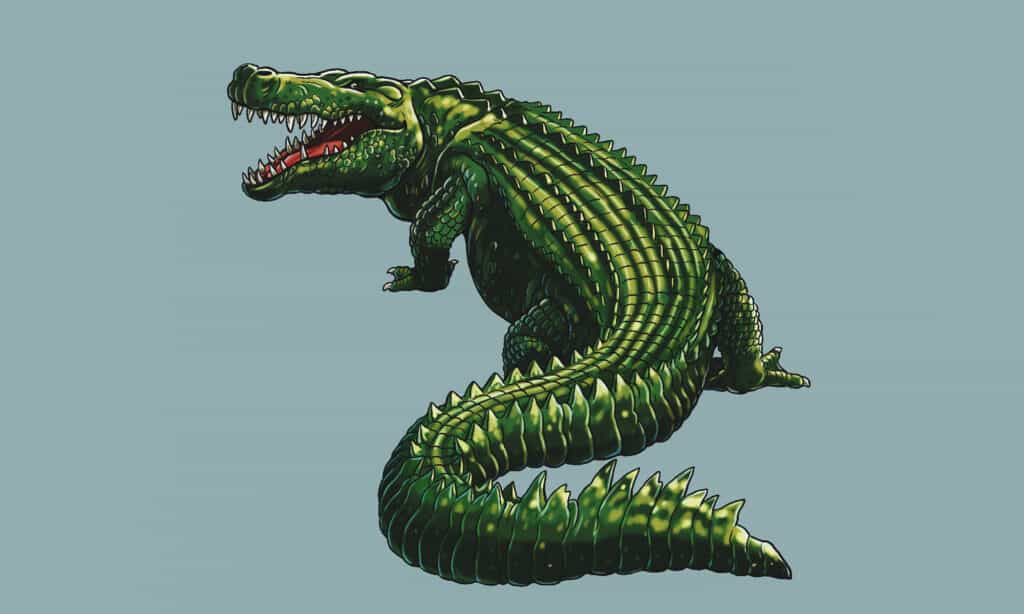
Deinosuchus lived during the Cretaceous era
©Sammy33/Shutterstock.com
However, alligators today are much, much smaller than their prehistoric counterparts. One of the most fearsome alligators to ever exist was Deinosuchus – an immense 35-foot-long alligator with a bite force of up to 100,000 Newtons. Deinosuchus had a massive, wide skull and thick teeth which were used for crushing prey rather than piercing it. Deinosuchus lived 82 to 73 million years ago during the Cretaceous era and spent their time in brackish water near estuaries. Fossilized remains have been found in 10 US states so far – including Texas. Therefore, Deinosuchus could well be the largest alligator to have ever existed in Texas.
The photo featured at the top of this post is © iStock.com/cturtletrax
Thank you for reading! Have some feedback for us? Contact the AZ Animals editorial team.






